Make anything you want, with free music software of your choice, and <1ms latency. Bela is back, smaller than ever - a pocket-sized £120 computer for sound.
Embedded mobile tech has in recent years brought us pocket-sized, low-power boards that can match the performance of what not so many years ago we actually called a desktop computer. And that’s led to high-profile boards like the cheap Raspberry Pi. The problem has been, many of the cheapest of these machines were limited in computational power, and more importantly, had audio performance that ranged from middling to disastrously awful, both in audio quality and reliability/responsiveness.
But you shouldn’t settle for that. The whole point of building an embedded audio system dedicated to the task of music making – like a DIY effects pedal or synth or sound installation – ought to be that audio performance is better than on your PC. You’ve got a pocket-sized board that isn’t running weird file indexing, OS updates, buggy Facebook code open in twenty tabs, and the like. It ought to just do the number crunching you need for the granular delay you want to sing along with, and do it really well.
A few audio engineers have decided to brave the challenge. It’s not an easy thing to do: these little boards are so cheap that there’s not a whole lot of money to be made on them.
But one of the better projects has been Bela, first introduced in 2016. And today, its makers are taking advantage of a new board PocketBeagle board from beagleboard.org. It’s more powerful than that much-hyped Raspberry Pi, but runs on a battery and is absurdly small – the Bela Mini measures just 55x35x21mm. (Please do not eat your Bela Mini, or Tide Pods, or anything that isn’t food.)
It’s not just a small computer, though – there’s more.
Low latency. 1ms round-trip for audio, or a minuscule 100us round-trip via analog and digital I/Os.
Run your favorite free audio software. Support for the graphical patching environment Pure Data (Pd), the crazy-powerful code world of SuperCollider, plus C and C++, and community support for FAUST, Python, etc.
An IDE in your browser. Fire up your browser and use a built-in IDE with oscilloscope and spectral analysis and documentation and more.
Sensors! High-resolution sensor inputs onboard open up interesting interfacing with the real world, whether you’ve got a wearable technology idea, an interactive installation, or a unique custom interface.
The applications should be clear here. You could ditch your laptop and run a granular looper on a pocket-sized box. You could hook up some sensors and invent your own weird instrument. You could make a custom vocoder and bring this with a mic and croon along at “robot lounge night.” You could produce a runway show of electronically singing couture. You could devise a series of installations and turn into the next Nam June Paik and someday have a solo show at the Guggen– well, possibly at least some hipster gallery somewhere. You get the idea.
For now, that unique focus on audio makes this possibly the best game in town. There is one rival – the Pisound, a board that hops atop the Raspberry Pi, and couples with a custom case. The Pisound does have the advantage of onboard MIDI – both USB MIDI and MIDI DIN – but for computational power with audio, the Beagle looks stronger. (I could imagine doing an audio/MIDI application with Pisound and coupling it with an audio/sensor creation with Bela.)
Bela winds up pricing out pretty nicely, too. The smart buy is a £120 all-in-one kit (£110 intro price through March 9). That gets you cables, the Bela, the PocketBeagle base board, and a pr-flashed SD-card. If you prefer to source your own parts, you can get just the Bela Mini for £60 (£55 intro).
It’s bigger, but the original Bela has basically the same specs and ships now if what I’ve done is make you impatient to own one now, rather than wait for May.
Basically, what’s new on the Bela Mini is really the tiny size. That opens up projects where small size matters. (The Pisound above is really just about music projects, more than wearable tech and the like, by contrast – but of course by virtue of being larger affords more space for full-sized ports!) The original Bela will remain available, with “capelets” for adding additional features.
Either way, if you’re quick, you can get out of the studio and have your battery-powered box to make weird experimental music for your friends at the beach all summer long. (Or, southern hemisphere readers, let’s say keeping your friends warm with your July beatbox busking.)
And all for the price of one basic Eurorack module. Who said electronic music was just for the rich kids?
Full specs:
Based on the PocketBeagle (http://www.beagleboard.org/pocket) with a custom hardware cape and low-latency operating system
1GHz ARM Cortex-A8 processor, 512MB RAM (based on Octavo Systems OSD335x system-in-package)
Stereo audio I/O with integrated headphone amplifier (16 bit, 44.1kHz)
8x 16-bit analog inputs for sensors (DC-coupled; up to 44.1kHz for 4 inputs or 22.05kHz for 8 inputs)
16x digital I/Os (3.3V level)
USB host and device ports
Dimensions 55 x 35 x 21mm (including PocketBeagle)Software:
Latency as low as 0.5ms (analog/digital input to audio output) or 1.0ms (audio input to audio output)
Browser-based IDE including oscilloscope, spectrum analyser, interactive pin diagram and onboard documentation
Support for C, C++, Pd and SuperCollider languages. Community-contributed support for FAUST, Python and others
Buy it:
https://shop.bela.io
Sample projects:
http://blog.bela.io/
Resources:
http://github.com/BelaPlatform
http://github.com/BelaPlatform/bela/wiki
http://forum.bela.io

